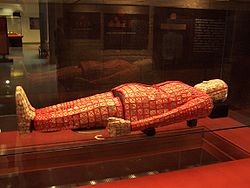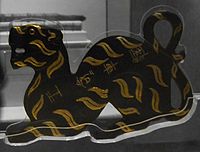- Museum of the Mausoleum of the Nanyue King
-
Coordinates: 23°8′25.36″N 113°15′22.15″E / 23.1403778°N 113.2561528°E
Museum of the Mausoleum of the Nanyue King 西汉南越王博物馆
Jade burial suit of King Zhao MoEstablished 1988 Location Guangzhou, China Type Mausoleum Curator Unknown The Museum of the Mausoleum of the Nanyue King (Chinese: 西汉南越王博物馆; pinyin: Xī Hàn Nányuè Wáng Bówùguăn; literally "Western Han Nanyue King Museum") is a museum in Jiefangbei Road, Yuexiu District, Guangzhou, southern China. With an area of 1,4000 sq. m, the tomb is the witness of Guangzhou’s history of over 2,000 years. It is well known for its well-preserved tomb and funerary antiquity from the Han Dynasty, as well as elegant and grand architecture from the Lingnan (south of the Nanling Mountain) area.
The owner of the tomb is the second king of Nanyue, Zhao Mo (r. 137 BC – 122 BC).
Contents
Layout
Hidden 20 meters (65.6 feet) underground, the tomb is made up of 750 huge stones with colorful murals. The over 1,000 pieces of cultural relics, bronzeware and terra cotta ware in particular, feature the Yue Culture of south China (Nanyue Culture). Represented also are traces of central Chinese culture, the Chu culture of south China, the Bashu culture of southwest China, the Hun culture from the northern grassland, and even foreign cultures.
The tomb was discovered in 1983 and the museum opened in 1988.[1] It is 20 meters under Xianggang Shan (Elephant Hill) in Guangzhou on a construction site for a hotel, and was excavated. The tomb is nearly 11 meters long and over 12 meters wide. It is divided in seven parts, with a front chamber, east and west wing rooms, the main coffin chamber, east and west side rooms, and a back storage chamber.
Artifacts
The tomb has yielded more than 1,000 burial artifacts, a chariot, gold and silver vessels, musical instruments, and human sacrifices were found (15 courtiers were buried alive with him to serve him in death). It is also the only tomb of the early Western Han Dynasty that has murals on its walls.
The tomb also yielded the oldest imperial seal discovered in a Chinese tomb: the seal declared the royal corpse to be "Emperor Wen" (Wen-di), indicating that he considered himself equal in rank to the Han ruler.
Alongside Chinese artifacts, pieces from the steppes, and Iranian and Hellenistic Central Asian regions have been found: a Persian silver box found in the tomb is the earliest imported product found to date in China.
A silk-jade garment made up of 2,291 pieces of jade is the spotlight of the mausoleum. It is acknowledged that jade garments with pieces connected by gold, silver, or copper are not uncommon. But this garment is unique for its jade pieces connected by silk which makes it the only one of its kind in the world. Nor are historical records available to verify other jade garments connected by silk thread. In addition, the style of buttons down the front is unique among unearthed jade garments. This silk-sewn-jade garment shows the early development of jade garments as well as development of the Nanyue culture.[2]
See also
External links
References
- ^ "Museum of the Western Han Dynasty Mausoleum of the Nanyue King". http://www.gzwh.gov.cn/whw/channel/whmc/bwg/nywmbwg/index.htm. Retrieved 2008-02-14.
- ^ "History of Museum of the Western Han Dynasty Mausoleum of the Nanyue King". http://www.gznywmuseum.com/index_1.htm. Retrieved 2008-02-14.[dead link]
Categories:- Archaeology museums in China
- Buildings and structures in Guangzhou
- Han Dynasty
Wikimedia Foundation. 2010.



